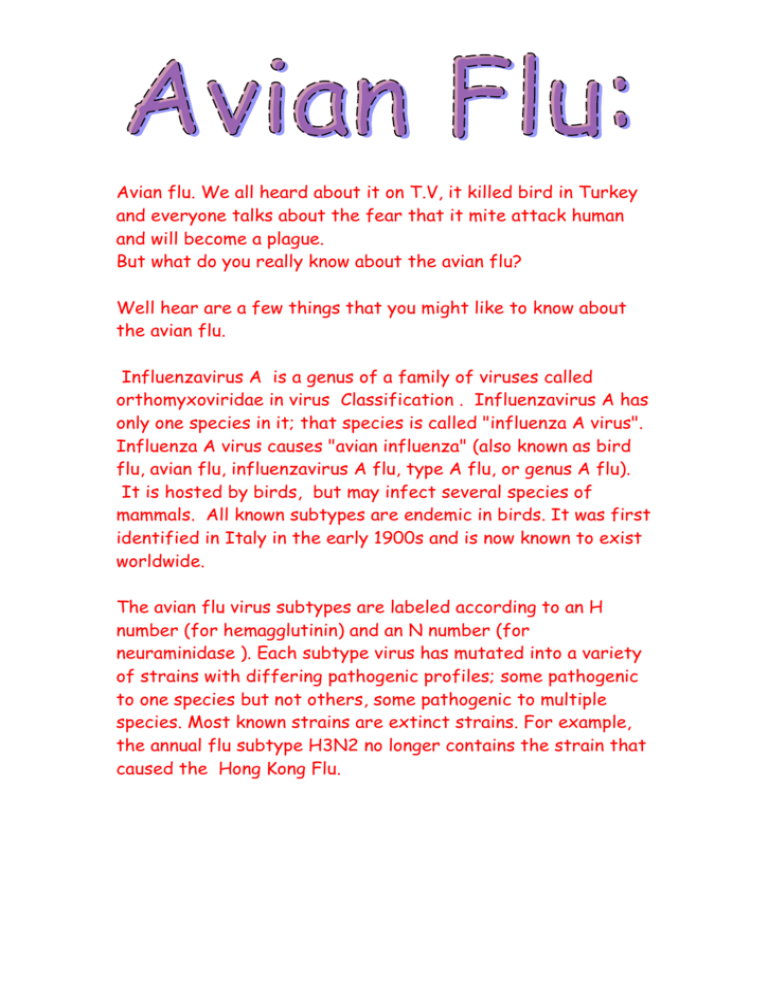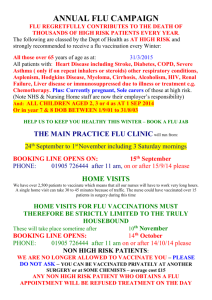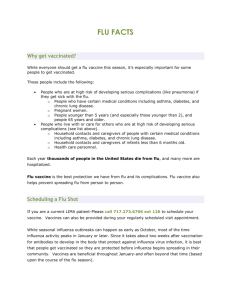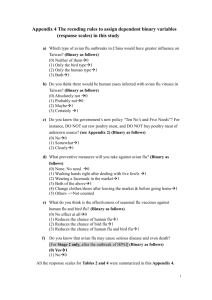Avian flu. We all heard about it on T.V, it killed bird in Turkey
advertisement

Avian flu. We all heard about it on T.V, it killed bird in Turkey and everyone talks about the fear that it mite attack human and will become a plague. But what do you really know about the avian flu? Well hear are a few things that you might like to know about the avian flu. Influenzavirus A is a genus of a family of viruses called orthomyxoviridae in virus Classification . Influenzavirus A has only one species in it; that species is called "influenza A virus". Influenza A virus causes "avian influenza" (also known as bird flu, avian flu, influenzavirus A flu, type A flu, or genus A flu). It is hosted by birds, but may infect several species of mammals. All known subtypes are endemic in birds. It was first identified in Italy in the early 1900s and is now known to exist worldwide. The avian flu virus subtypes are labeled according to an H number (for hemagglutinin) and an N number (for neuraminidase ). Each subtype virus has mutated into a variety of strains with differing pathogenic profiles; some pathogenic to one species but not others, some pathogenic to multiple species. Most known strains are extinct strains. For example, the annual flu subtype H3N2 no longer contains the strain that caused the Hong Kong Flu. Human influenza virus: "Human influenza virus" usually refers to those subtypes that spread widely among humans. H1N1, H1N2 and H3N2. are the only known avian flu virus subtypes currently circulating among humans. In humans, avian flu viruses cause similar symptoms to other types of flu These include fever, cough , sore throat, muscle aches, conjunctivitis and, in severe cases, severe breathing problems and pneumonia that may be fatal. The severity of the infection will depend to a large part on the state of the infected person's immune system and if the victim has been exposed to the strain before, and is therefore partially immune. In one case, a boy with H5N1 experienced diarrhea followed rapidly by a coma without developing respiratory or flu-like symptoms, suggesting non-standard symptoms. The avian influenza subtypes that have been confirmed in humans ordered by the number of known human deaths, are: H1N1 caused "Spanish flu", H2N2 caused "Asian Flu", H3N2 caused "Hong Kong Flu", H5N1 is the current pandemic threat, H7N7 has unusual zoonotic potential. H1N1: A variant of H1N1 was responsible for the Spanish flu pandemic that killed some 50 million to 100 million people worldwide over about a year in 1918 and 1919. H2N2: The Asian flu was a pandemic outbreak of H2N2 avian influenza that originated in Chaina in 1957, spread worldwide that same year during which a flu vaccine was developed, lasted until 1958 and caused between one and four million deaths. H3N2: H3N2 evolved from H2N2 by antigenic shift and caused the Hong Kong Flu pandemic of 1968 and 1969 that killed up to 750,000. H5N1: H5N1 is a highly pathogenic form of avian influenzavirus. Since 1997 , outbreaks of H5N1 flu have caused the death or culling of tens of millions of birds. Over 100 people have been infected by H5N1, with a mortality rate of over 50%. H5N1 has been the focus of much concern amid warnings that the H5N1 strain will likely evolve into a form that causes a global human pandemic with a very high mortality rate. As of November 1, 2005 , 184 cases of infections in humans, resulting in 85 deaths, have been confirmed outside of China. H7N7: H7N7 has unusual zoonotic potential. In 2003 in Netherlands 89 people were confirmed to have H7N7 influenza virus infection following an outbreak in poultry on several farms. One death was recorded.







